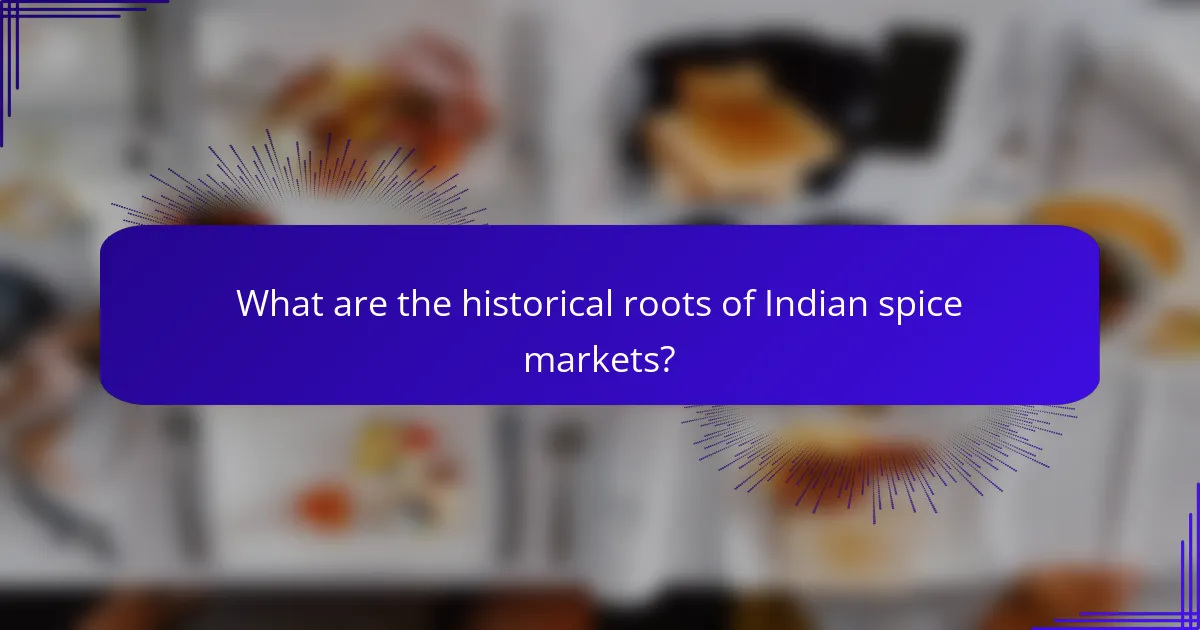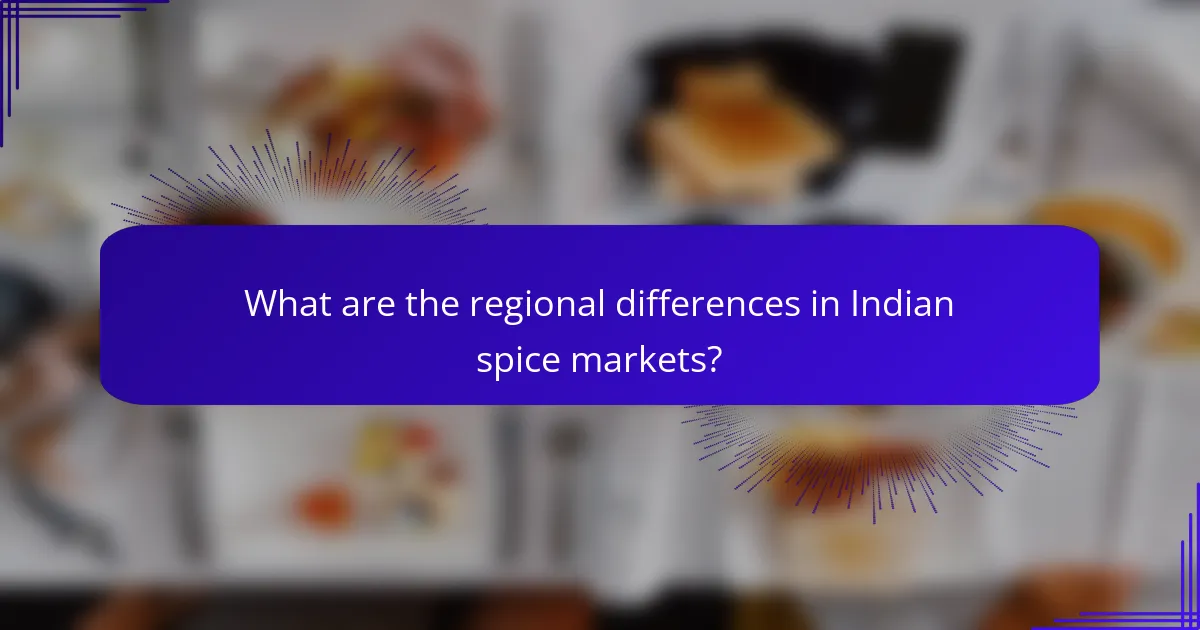
What are the historical roots of Indian spice markets?
Indian spice markets have deep historical roots dating back to ancient trade routes. The Indus Valley Civilization (c. 2500-1900 BCE) was one of the earliest known societies to cultivate spices. Archaeological evidence shows that spices like black pepper and cardamom were traded along the Silk Road. By the first century CE, Indian spices gained popularity in Roman markets. The spice trade flourished during the medieval period, attracting European explorers. The Portuguese and Dutch established trade monopolies in the 15th and 16th centuries. This led to the establishment of spice plantations in India. Today, Indian spice markets reflect this rich heritage, showcasing diverse regional spices.
How did trade routes influence the development of these markets?
Trade routes significantly influenced the development of Indian spice markets. They facilitated the exchange of spices between different regions and cultures. This exchange led to increased demand for various spices, enhancing market growth. Historical trade routes, such as the Silk Road and maritime paths, connected India with Europe, the Middle East, and Asia. These connections allowed for the introduction of new spices and flavors into local cuisines. The influx of foreign traders also stimulated competition among local producers. Consequently, this competition improved quality and innovation in spice production. Furthermore, trade routes contributed to the establishment of price standards for spices. This standardization helped stabilize the markets and encouraged further trade expansion. Overall, trade routes were crucial in shaping the dynamics of Indian spice markets.
What ancient civilizations played a role in the spice trade?
Ancient civilizations that played a role in the spice trade include the Egyptians, Greeks, Romans, and Chinese. The Egyptians traded spices as early as 3000 BCE, using them for embalming and cooking. The Greeks expanded the spice trade during the Hellenistic period, establishing trade routes to India and Arabia. The Romans further developed these routes, importing spices like pepper and cinnamon to enhance their cuisine. The Chinese engaged in spice trade through the Silk Road, exchanging goods with various cultures. These civilizations significantly influenced the demand and distribution of spices across continents.
How did colonialism impact Indian spice markets?
Colonialism significantly transformed Indian spice markets. European powers, particularly the British and Dutch, established control over spice trade routes. They prioritized cash crops, leading to the decline of diverse local agriculture. This shift caused a focus on export-oriented production, often at the expense of local consumption. The introduction of new trade regulations affected pricing and market access for local producers. Additionally, colonial powers monopolized trade, limiting competition and driving many local merchants out of business. As a result, colonialism reshaped the structure and dynamics of Indian spice markets, favoring foreign interests over local economies.
What are the key milestones in the evolution of spice markets in India?
The key milestones in the evolution of spice markets in India include the establishment of the Spice Route in ancient times. This route facilitated trade between India and various civilizations, enhancing spice demand. The introduction of spices like black pepper and cardamom in the 1st century CE marked significant commercial activity. The arrival of European traders in the 15th century boosted the spice trade, with the Portuguese and Dutch establishing control over spice-producing regions. The British colonization in the 18th century further integrated Indian spices into global markets. Post-independence, the Green Revolution in the 1960s modernized spice cultivation. Today, India stands as the largest producer and exporter of spices, with a market valued at over $3 billion.
What major events shaped the spice trade in India?
The spice trade in India was shaped by several major events. The arrival of European traders in the 15th century marked a significant shift. Portuguese explorer Vasco da Gama reached India in 1498, establishing sea routes for spices. The Dutch East India Company followed in the 17th century, competing for control over spice trade. British colonial rule further transformed the market, leading to the establishment of plantations. The discovery of new spices and their global demand fueled trade expansion. The abolition of the monopoly on spices in the 19th century opened markets to competition. These events collectively influenced the dynamics of the spice trade in India.
How did the introduction of global trade affect local markets?
The introduction of global trade significantly transformed local markets. Local producers gained access to broader markets for their goods. This increased competition often led to lower prices for consumers. Additionally, global trade introduced new products to local markets. Indian spices, for example, became highly sought after internationally. This demand boosted local economies and enhanced livelihoods for farmers. Historical records indicate that the spice trade flourished during the 15th and 16th centuries. The influx of foreign merchants also brought diverse cultural influences. These changes shaped local consumption patterns and culinary practices.

What are the regional differences in Indian spice markets?
Indian spice markets exhibit significant regional differences influenced by geography, climate, and culture. In the southern region, spices like cardamom, black pepper, and turmeric are prominent due to the favorable climate. The Kerala spice market is particularly known for its high-quality black pepper and cardamom exports.
In contrast, northern markets focus on spices such as saffron and cumin. Kashmir is renowned for its saffron production, which thrives in its unique climate.
Western India, particularly Gujarat and Rajasthan, emphasizes dry spices like coriander and fenugreek. These regions have a tradition of using spices in their distinct cuisine.
Eastern India, especially West Bengal, features spices like mustard and nigella seeds, reflecting local culinary practices. Each region’s spice market is shaped by its agricultural practices and consumer preferences.
Overall, the diversity in Indian spice markets highlights the rich culinary heritage and regional specialties across the country.
How do spice varieties differ across Indian regions?
Spice varieties differ significantly across Indian regions due to climate, geography, and cultural practices. For instance, southern India is known for its use of curry leaves and coconut, while northern India favors spices like cumin and coriander. The western region, particularly Gujarat, is famous for its unique blend of spices known as garam masala. Eastern India, especially West Bengal, often incorporates mustard seeds and nigella. Each region’s cuisine reflects its local agricultural practices and historical trade routes. The diversity in spices contributes to the rich tapestry of Indian culinary traditions.
What spices are unique to specific regions in India?
Black pepper is unique to the Malabar Coast of Kerala. It is known for its strong flavor and aroma. Saffron is specific to the Kashmir region. It is prized for its color and fragrance in dishes. Mustard seeds are commonly found in the eastern states, particularly West Bengal. They add a distinct pungency to local cuisines. Fennel seeds are unique to the northern regions, especially in Rajasthan. They are often used in sweets and savory dishes. Cardamom is primarily grown in the Western Ghats, particularly in Kerala. It is celebrated for its sweet and spicy flavor in various culinary applications. Each of these spices plays a significant role in the regional cuisines of India, reflecting local agricultural practices and cultural preferences.
How do climate and geography influence spice cultivation?
Climate and geography significantly influence spice cultivation. Warm temperatures and adequate rainfall create ideal conditions for spice growth. Regions near the equator, such as India, experience consistent climates that support diverse spices. The specific soil types and topography also affect which spices can thrive. For example, black pepper grows well in tropical climates with rich, well-drained soils. Additionally, spices like cardamom require high humidity and shade, which is often provided by forested areas. Geographic factors like altitude can alter temperature and rainfall patterns, impacting spice yield and quality. Historical data shows that regions with favorable climates have been spice cultivation centers for centuries, demonstrating the critical role of these factors.
What cultural factors contribute to regional spice market variations?
Cultural factors significantly influence regional spice market variations. Local culinary traditions dictate spice preferences in different regions. For instance, southern Indian cuisine favors coconut and curry leaves, while northern regions prefer garam masala. Historical trade routes have also shaped spice availability and usage. Regions with historical ties to trade, like Kerala, have diverse spice offerings. Religious practices impact spice use; certain spices may be preferred or avoided based on dietary restrictions. Festivals and local customs often dictate the seasonal demand for specific spices. Additionally, cultural heritage influences the methods of spice preparation and preservation. These factors collectively create distinct spice markets across India.
How do local cuisines shape the demand for specific spices?
Local cuisines significantly influence the demand for specific spices. Each region’s culinary traditions dictate the types of spices that are commonly used. For instance, Indian cuisine is known for its rich use of spices like turmeric and cumin. These spices are integral to traditional dishes, enhancing flavor and aroma.
Cultural practices also play a role. Certain spices are linked to specific festivals or rituals. For example, saffron is often used in celebratory dishes, increasing its demand during festive seasons. Additionally, local agricultural conditions affect spice availability. Regions with favorable climates produce particular spices in abundance, shaping local preferences.
Market trends further reflect these culinary influences. As global interest in Indian cuisine rises, the demand for spices like garam masala has increased internationally. This trend showcases how local cuisines can extend their influence beyond geographical boundaries, impacting spice markets globally.
What festivals or traditions highlight regional spices?
Various festivals and traditions highlight regional spices in India. The Pongal festival in Tamil Nadu celebrates the harvest and features rice cooked with spices like black pepper and cumin. In Kerala, the Onam festival showcases a grand feast called Onam Sadhya, which includes dishes flavored with spices such as cardamom and cloves. The Durga Puja in West Bengal emphasizes the use of mustard seeds and other spices in traditional dishes. In Gujarat, the Navratri festival highlights the use of spices in fasting foods. Each of these festivals reflects the local culinary heritage and the significance of spices in regional cuisines.

What are the culinary uses of spices in Indian cuisine?
Spices in Indian cuisine are used for flavoring, preserving, and enhancing the nutritional value of dishes. They are integral to creating complex flavor profiles in various regional dishes. Common spices include cumin, coriander, turmeric, and cardamom. Each spice contributes unique aromas and tastes. For example, turmeric adds earthiness and color, while cardamom imparts sweetness and fragrance. Spices also have medicinal properties, promoting digestion and overall health. Historical trade routes facilitated the introduction of diverse spices into Indian cooking. This rich tapestry of spices makes Indian cuisine distinct and globally celebrated.
How are spices utilized in traditional Indian cooking?
Spices are integral to traditional Indian cooking, enhancing flavor and aroma. They are used in various forms, including whole, ground, and as pastes. Spices like cumin, coriander, and turmeric are commonly incorporated into dishes. They are often combined in specific blends called masalas. Cooking techniques such as tempering release the essential oils in spices. This method involves heating spices in oil to maximize their flavor. Additionally, spices provide health benefits, contributing to digestion and anti-inflammatory properties. Historically, the use of spices has been rooted in India’s culinary practices for centuries, influencing regional cuisines across the country.
What are the common methods of spice preparation?
Common methods of spice preparation include grinding, toasting, and infusing. Grinding spices increases surface area, enhancing flavor release in dishes. Toasting spices in a dry pan intensifies their aroma and taste. Infusing spices in oils or liquids allows for gradual flavor extraction. Each method is crucial for maximizing the culinary potential of spices. Historical practices in Indian cuisine often incorporate these techniques to achieve depth in flavor. For instance, freshly ground spices are preferred for their potency. Toasting is a traditional method used in many Indian recipes to elevate flavors.
How do spices enhance flavor and aroma in dishes?
Spices enhance flavor and aroma in dishes by introducing unique compounds that stimulate taste and olfactory receptors. These compounds include essential oils and aromatic molecules. For example, cumin contains cuminaldehyde, which adds warmth and depth. Cardamom is rich in cineole, contributing a fresh and citrusy note. Spices also create a balance of flavors, such as sweet, salty, bitter, and umami. This complexity makes dishes more appealing and satisfying. Additionally, spices can evoke cultural and emotional connections through their scents and tastes. Historical evidence shows that spices have been traded for thousands of years, emphasizing their importance in culinary traditions.
What health benefits are associated with Indian spices?
Indian spices offer numerous health benefits. Turmeric contains curcumin, known for its anti-inflammatory properties. Ginger aids digestion and reduces nausea. Cinnamon can help regulate blood sugar levels. Cumin is rich in antioxidants and supports immune function. Cardamom may improve oral health and digestion. Cloves possess antimicrobial properties and can reduce inflammation. These spices are integral to traditional medicine systems like Ayurveda, supporting overall wellness. Studies have shown that regular consumption of these spices can enhance health and prevent chronic diseases.
Which spices are known for their medicinal properties?
Turmeric, ginger, garlic, and cinnamon are spices known for their medicinal properties. Turmeric contains curcumin, which has anti-inflammatory and antioxidant effects. Ginger is recognized for its ability to alleviate nausea and digestive issues. Garlic has been shown to support heart health and boost the immune system. Cinnamon may help regulate blood sugar levels and has anti-microbial properties. These spices have been used in traditional medicine for centuries, backed by various studies confirming their health benefits.
How do spices contribute to overall health and wellness?
Spices contribute to overall health and wellness through their antioxidant, anti-inflammatory, and antimicrobial properties. These properties can help reduce the risk of chronic diseases. For example, turmeric contains curcumin, which has been shown to lower inflammation and improve heart health. Cinnamon can help regulate blood sugar levels, making it beneficial for those with diabetes. Garlic has been linked to improved immune function and cardiovascular health. Ginger is known to aid digestion and reduce nausea. Studies indicate that regular consumption of spices can enhance overall well-being and promote longevity.
What tips can enhance the experience of exploring Indian spice markets?
To enhance the experience of exploring Indian spice markets, engage your senses fully. Observe the vibrant colors of spices displayed in abundance. Smell the rich, aromatic scents that define each spice. Taste samples offered by vendors to appreciate the flavors. Interact with local vendors to gain insights about the spices. Learn about their origins and uses in traditional cuisine. Visit during local festivals for a lively atmosphere and unique offerings. Bring cash for easier transactions, as many vendors may not accept cards. Research the specific spices of the region you are visiting to enrich your understanding and appreciation.
The main entity of the article is Indian spice markets, which have a rich historical background and significant regional variations. The article examines the historical roots of these markets, tracing their development from ancient trade routes to modern-day practices, highlighting key civilizations and events that shaped the spice trade. It also explores regional differences in spice varieties and culinary uses, detailing how geography, culture, and local cuisines influence spice demand and preparation methods. Additionally, the article discusses the health benefits associated with Indian spices and offers tips for enhancing the experience of exploring spice markets.
